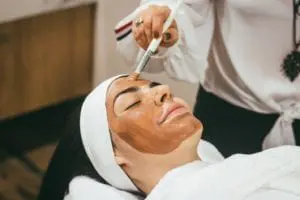A chemical peel is meant to stimulate growth of new cells, enhancing your skin’s appearance on the hands, neck and face. When the chemical solution is applied to the skin, it exfoliates and peels off. As a result, the new layer of skin has fewer wrinkles and appears smoother.

Types of Chemical Peels
Essentially, there are three types of chemical peels:
Superficial peel
This type of peel is suggested for skin with mild discoloration or roughness. The peel works for the face, hands, and neck, leaving it refreshed.
Medium peel
This treatment is done for moderate skin discoloration. It helps remove wrinkles, age spots and fine lines. The procedure consists of glycolic acid application to remove damaged skin cells. It’s also used on rough skin to smoothen it and to treat conditions such as actinic keratosis.
Deep peel
This procedure requires the application of trichloroacetic acid to penetrate the centre layer of skin and remove damaged skin cells. It improves shallow scars, freckles and age spots along with moderate lines. Even though it can only be performed once, it shows dramatic improvement in the appearance of your skin.
Why Do People Opt for Chemical Peels?
Peels are quite popular, and if done correctly, they can you the results you desire. However, it is to understand how different ingredients work on different skin types and the effect they have during and after treatment. Therefore, to have thorough knowledge about what a person may be getting themselves into, it is crucial to have a consultation and analysis and have realistic expectations about the results.
The type of chemical peeling the aesthetician suggests depends on your skin type and the results you want. Some concerns peeling helps address include:
- Improving skin texture and tone
- Anti-ageing
- Reducing lines and wrinkles
- Cell renewal
- Open pores
- Acne
- Pigmentation and photodamage
- Brighter skin
- Skin structure renewal
How Are Chemical Peels Applied?
Light peel
During a light chemical peeling, the professional will apply a chemical solution to the target area using a brush, cotton ball or gauze. Once your skin starts to whiten, there may be a slight stinging sensation. Once the procedure is complete, the professional will peel the chemical solution off and add a neutralizing solution.
Medium peel
During most medium chemical peels, professionals use a special sponge or gauze to put the chemical solution on your skin. The solution may contain glycolic or trichloroacetic acid. Once your skin starts to whiten, a cool compress will be applied to it. You may feel a burning or stinging sensation for 20 minutes. Even though a neutralizing solution is not necessary, you can use a handheld fan to cool your skin. Since blue color is also added in the solution sometimes, your skin may appear blue for a few days following the peel.
Deep peel
You may be given sedation during a deep peel procedure. Your doctor may apply phenol using a cotton applicator. The procedure is usually performed in 15-minute sessions to avoid acid exposure on the skin.
Complications and Side Effects
The following may occur as a result of chemical peeling:
- Scarring
- Permanent or temporary change in skin color (mostly for women who are on birth control pills)
- Cold sore reactivation
- Post-inflammatory hyperpigmentation
- Acne
- Breakouts of spots
- Herpes simplex
During the consultation, the possible side effects and complications should thoroughly be explained to the patient. Moreover, it is always a good idea to take pictures before and after the procedure for comparison.
Moreover, risks should always be minimized through:
- Consultations
- Good peel preparation skills
- Good application skills
- The right aftercare advice
Chemical Peeling Aftercare
Aftercare for Superficial Peeling
Superficial peeling is followed by slight redness and scaling, and may require up to seven days to heal. The following can be done in the meanwhile to fasten the healing process:
- Apply lotion or cream till the skin heals
- Use sunscreen daily
- Make-up can be worn the next day
Aftercare for Medium Peeling
While medium peels often require up to 14 days to heal, it often takes less time. Moreover, your skin after medium peeling may be swollen or red, and there may also be swelling on the eyelids. The following tips could help reduce any side effects:
- Soak your skin daily and then apply ointment
- Take prescribed antiviral medication for 10 to 14 days
- Apply mild lotion or cream
- Avoid exposure to the sun
- Don’t apply make-up immediately (wait for 5-7 days)
Aftercare for Deep Peeling
Deep peeling could require as long as 21 days to heal. The following tips can help make the healing process more effective:
- Soak the skin four to six times every day
- Apply the ointment after soaking for 14 days
- Apply a thick moisturizer for the next 14 days
- Take antiviral medication (after consulting your doctor) for 10 to 14 days
- Apply mild cream or lotion
- Avoid exposure to the sun for up to six months
- Do not apply to make up for the first 14 days
- Have a follow-up appointment scheduled to monitor your progress
- Avoid smoking
How Much Does Chemical Peeling Cost?
Since chemical peeling comes under the category of cosmetic procedures, it will most likely go out of your pocket. Moreover, there is no fixed cost of the procedure as it depends on several factors, such as:
- The type of peel used
- Location
- Provider’s expertise
Deep peels usually cost the highest, while light peels are at the lower end of the price range. However, it again depends on whether you require anesthesia or in-patient stays. As per the American Society of Plastic Surgeons, a chemical peel costs about $644 on average.
There is no denying that chemical peels help make your skin appear smoother and younger. However, they are not without their drawbacks. Therefore, seek a professional’s guidance before setting up your final appointment. Be clear about your needs and take your professional’s advice into account for a smooth and trouble-free procedure.
For more information schedule appointment or contact us today.
SunCoast Skin Solutions Dermatology offices are located in Tampa / Hillsborough, St. Pete / Pinellas County , Brandon, Lutz, Winter Haven, Largo, Riverview, Brooksville, Ocala, and Daytona Beach, Sarasota, Punta Gorda, Seminole, Florida. Contact us at 1-844-786-3376 or click here.

Recent Comments